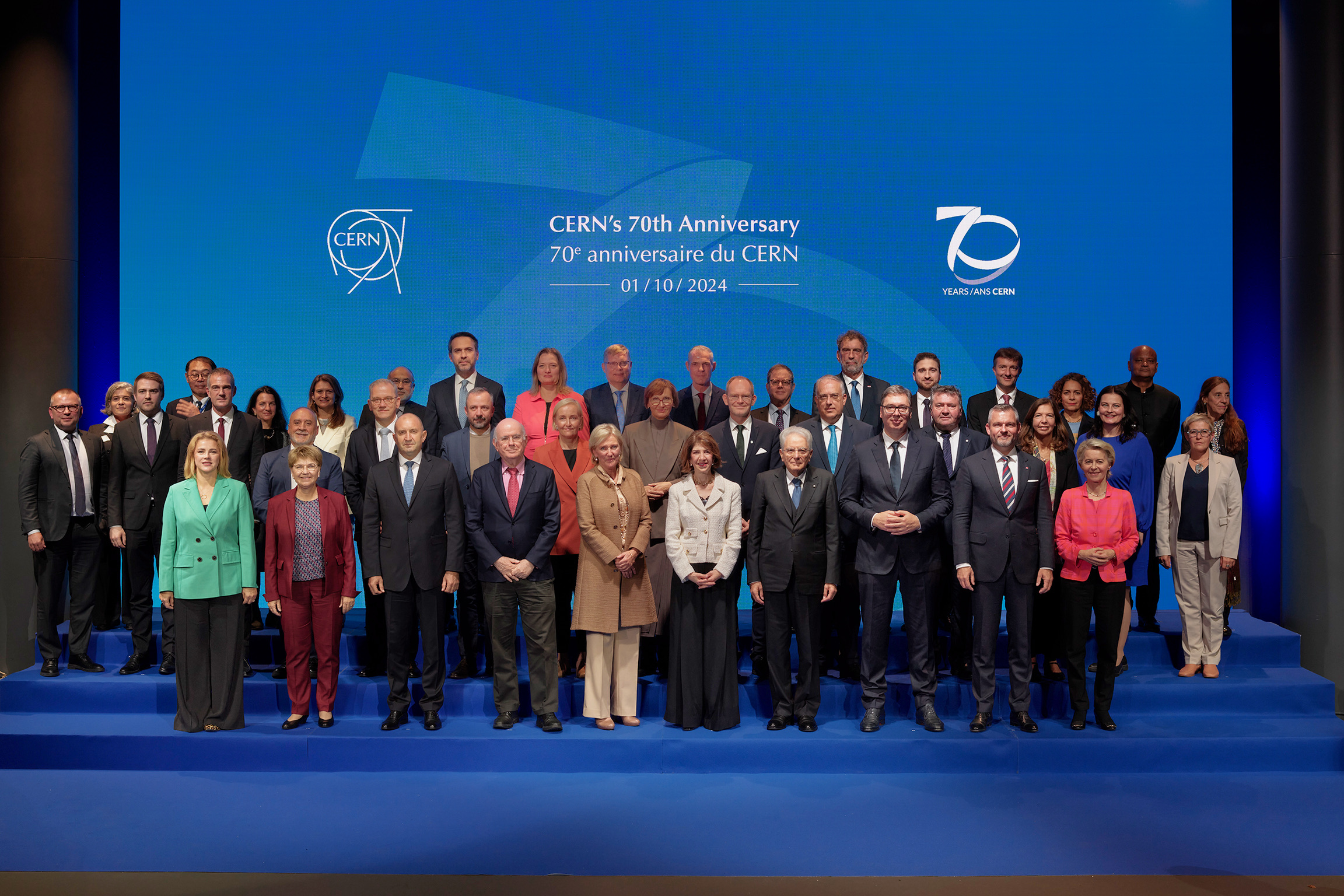Today, CERN, the European Laboratory for Particle Physics, is hosting a special high-level ceremony to celebrate its 70th anniversary, attended by 38 national delegations, including Heads of State and Government from Bulgaria, Italy, Latvia, Serbia, Slovakia and Switzerland, Her Royal Highness the Princess Astrid of Belgium, and the President of the European Commission. In addition to the national delegations, many scientific, political and economic leaders are also joining the celebration hosted in the CERN Science Gateway, the new hub for education and outreach bridging science to the general public.
This high level group of distinguished guests demonstrates the strong support for CERN’s mission and its ambition. CERN is the world’s leading laboratory for high-energy physics, it is a centre of development of advanced technologies, a platform for training and education and a brilliant example of collaboration across borders.
“I am very honoured to welcome representatives from our Member and Associate Member States, our Observers and our partners from all over the world on this very special day”, said Fabiola Gianotti, CERN Director-General. “CERN is a great success for Europe and its global partners, and our founders would be very proud to see what CERN has accomplished over the seven decades of its life. The aspirations and values that motivated those founders remain firmly anchored in our Organization today: the pursuit of scientific knowledge and technological developments for the benefit of humanity; training and education; collaboration across borders, diversity and inclusion; knowledge, technology and education accessible to society at no cost; and a great dose of boldness and determination to pursue paths that border on the impossible.”
CERN was born after the Second World War from the vision of a handful of eminent scientists and political leaders with a mission to bring excellence in scientific research back to Europe and foster peaceful collaboration among countries. As more powerful accelerators and experiments were built, foundational discoveries were made: among others, neutral currents were discovered in 1973, the W and Z bosons were discovered in 1983, extremely precise measurements of the Z boson and of other parameters of the Standard Model were made in the 1990s at the Large Electron–Positron (LEP) collider, and the Large Hadron Collider (LHC) started up in 2009 and the Higgs boson was discovered there in 2012. CERN has also generated innovations such as the multiwire proportional chamber that was invented in 1968 and is also famously known as the birthplace of the World Wide Web. Numerous technologies from CERN are used today in other fields, including medical diagnostics and therapy, aerospace and many more. Today, CERN has 24 Member States, 10 Associate Member States, 4 Observers, many other partners from all over the world, and a vibrant community of more than 17 000 people, representing more than 110 nationalities.
“CERN is living proof that human ingenuity knows no bounds when set on a common goal that transcends borders,” said Eliezer Rabinovici, President of the CERN Council. " When celebrating 70 years of CERN, we are celebrating the daring vision of the founding fathers. We are recognising the work of generations of CERN personnel that have made possible seminal scientific and technological contributions that led to uncovering the secrets of nature for the benefit of all humanity. CERN has brought Europe to the front line of human endeavours. It is my belief that CERN will continue to carry the torch, with the support of the European public and its leaders."
The CERN community continues to work tirelessly to uncover the many mysteries of the Universe. There is still much to learn about the Higgs boson, and many other puzzles remain about how and why matter in the Universe is the way it is. 95% of the Universe is dark to us, made of forms of energy and matter that we cannot see or understand. Discoveries, observations and measurements made at CERN over the decades, most recently at the LHC, are key to our understanding of the world we live in. The LHC has surpassed expectations, having already produced more data so far in its current third run than during the entire second run, the operation period spanning from 2015 to 2018.
Engineers, physicists and technicians are already focusing their attention on the High-Luminosity LHC, which aims to increase tenfold the amount of data collected by the experiments and greatly enhance their physics potential after 2030. Looking further ahead in time, CERN is currently performing a feasibility study for a possible new facility, the Future Circular Collider, which may become the most extraordinary instrument ever built to study the fundamental laws of nature and help to address many of the outstanding fundamental questions.
The year-long anniversary programme has seen over 100 events organised in 63 cities in 28 countries and at CERN, bringing together thousands of people to discuss the open questions in physics and the future of the field, the interplay between fundamental research and cutting-edge technology, CERN’s role as a brilliant model for international collaboration, and how training, education and accessibility can promote inclusiveness in the world of science.
Additional links
Follow the ceremony online, by Webcast or on YouTube.
Our media kit about CERN70 is here.
Additional pictures of the day will be uploaded here. The full replay, speeches and highlights, will be available on NewsDirect : https://newsdirect.ebu.ch/nodes/uuid:2b32b2b0-1f43-44f3-b6a9-8de488b412e0/details

